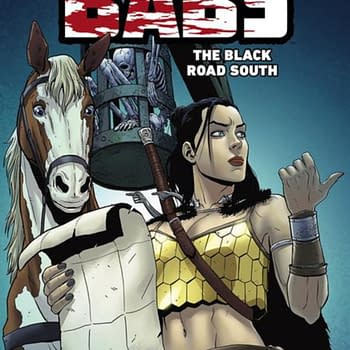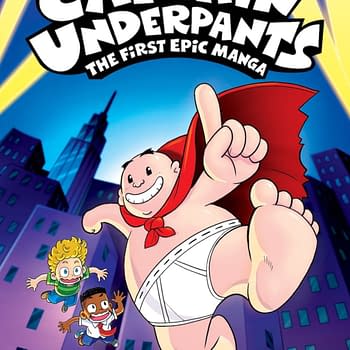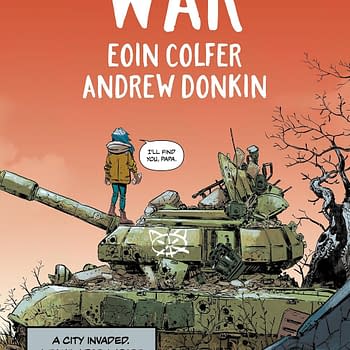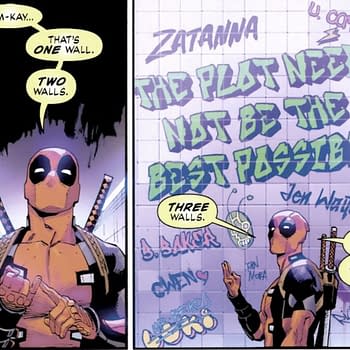Posted in: Comics | Tagged: art dealers, collectibles, comic art, Court Gebeau, entertainment, matt kindt
Inside The World Of A Comic Book Art Dealer – A Superhero Dojo Special
By Parker McCombe

So what exactly goes on in this side of the comic book industry and how does it work?
I sat down with Court Gebeau, the man behind comiconart.com and one of the industry's top dealers, to find out.
PMcC: First off, I needed to find out if he's a fan, like us, or did he just get into the business to earn a quick buck…
So, Court, how did you get into comics?
CG: Well, I started collecting comics at about 8 or 9 years old. I became insatiable. Going to the comic store was the highlight of my week. I loved GI Joe, Transformers, V, West Coast Avengers, Secret Wars…but my favourite was Amazing Spider-Man. I remember the first time I paid more than cover price for a comic – $8 for ASM 252. I carried that book around like it was a crown jewel. My most prized possession!
PMcC: Okay, so you are one of us. How the hell did you get into the business of being surround by your favourite art every day?
CG: A very good friend of mine was making a living as an art rep, and this blew my mind as he really had no background in comics, or any particular love or knowledge of the medium. One of his neighbours was an artist, and he started helping him sell his art, and he started getting referrals, and it just took off from there. I saw this, and thought that, if anything, I was the one meant for this job! I was the one who loved comics!
PMcC: So how did you get your first clients?
CG: I decided to start a website for artist representation. I was living in San Diego, and that's where the name 'Comiconart' comes from. My first two artists were Juan Ferreyra, who was working on his very first book – Small Gods for Image Comics, and Jasen Rodriguez – an inker who had left the industry a few years prior, and was selling through his back inventory of pages. So – one artist that was no longer active, and one artist that no one had heard of (yet). Shortly thereafter, I was approached by the Benes Studio about the possibility of representing the artists that were training with Ed Benes, and it just took off from there. Next thing I know, it's 11 years later, and my dream job has become my career!
PMcC: I had a dream job once! I say a dream job, because that's what I did all day instead of actually working. I'm sure that wouldn't wash in your line of work though, what exactly does the job entail?
CG: We handle all aspects of art sales for the artists, from selling art and commissions directly to customers through the site, to promotion of the artists' work through social media. We also help in all manner of planning and preparation for convention appearances. This includes, but is not limited to, registration for booth space at the con, booking accommodations for artists, ordering artist banners and merchandise (art prints, sketchbooks, etc.), arranging commission requests in advance of the show, handling all art sales and commission requests at the booth, recording all sales, co-ordinating CGC signature series opportunities for fans… The list goes on.
PMcC: What makes CCA different from other comic art sellers?
CG: I would say the main difference is my dual role as both an agent and an art rep. As such, I have ties to both sides of the comic art community (publishers and collectors), which can lead to some exciting and unique opportunities for the artists that I work with.
I am always looking for new ways to promote the careers of the artists I represent, and this extends far beyond just art sales.

CG: Yes, we work directly with publishers to find work for our artists. We send portfolios and page samples to editors, and help them to find the correct project for their talents. We also then negotiate page rates and contracts, manage artist deadlines, maintain communication with editors, track artist payments, and handle all business aspects of the industry so that the artist can focus all of their energy and attention on the work in front of them.
PMcC: Combining two aspects of the business like that sounds pretty demanding, are there many differences between how either side works?
CG: These two facets of the industry are very different, but also very symbiotic, and can very easily feed off of each other. For example, if I can find a great opportunity for a high profile new project, then that can also lead to stronger art sales for the artist, and higher visibility for their work. Pairing an artist with the right opportunity can do much more to further their career and promote their work than advertising their art sales through our mailing list, social media, etc. A great project will sell itself just by being great. It's always easier to sell the high profile work.
Some CCA artists are solely on the art sales side, others are solely on the agency side, and several fall into both categories. I always try to cater my services to the individual needs of each artist. As I often tell the artists I work with: "My job is to make your job easier in any way possible." As such, my role is constantly evolving.
PMcC: What's the most difficult part of your job?
CG: I think, as with most jobs, it's just managing all of the different individual personalities / tendencies / preferences. To be fair, artists tend to be a bit more mercurial than your typical '9 to 5' crowd, while deadlines are always a top priority for publishers. Finding the middle ground and maximizing results for all involved is always a challenge.
PMcC: Despite the challenges, dealing with comic book art all day is bound to be pretty cool?
CG: Honestly – this is my dream job. Every day I get to work in an industry that I love – with artists, editors, and publishers that I respect and admire. I've had jobs in the past that made me miserable, and there is nothing worse than waking up every morning dreading going to work. For me, it's the exact opposite. Every day I wake up excited to get back to work. And, in all honestly, I enjoy my job to the point that I'd likely keep on doing it even if it wasn't paying the bills. In many ways, my job is also my hobby.
PMcC: I think if I was commissioning some art it would probably me walking to my car like Kaneda on the Akira movie poster or Starscream riding a horse like Napoleon Crossing the Alps, so I can imagine that you would receive some pretty interesting and off the wall requests from time to time. Do any particular requests stand out to you?
CG: At this point, after 10 years, I think I've heard just about everything. Then another request comes in that takes me by surprise! Unfortunately, the strangest requests likely aren't fit for print – but I'll tell you all about them over a beer or two. There is one in particular that pops to mind that I would love to share.
PMcC: Beer or three. And yes, I'll hold you to that. So what's the coolest thing someone's commissioned?
CG: It's definitely tough to pin down one particular piece. I am always impressed by some of the 'theme' commissions that come in (collectors that request similar themed pieces from several different artists). For example – there is one collector who requests "One Minute Later" commissions. In this case, he wants an artist to take a classic comic cover, and depict the events of that cover scene one minute later to see what happens next. There is another collector that likes to do cover homages to classic covers, but replacing all of the characters with members of the League of Super-Heroes… And still another who collects "Throne Room" commissions (major villain on a throne with the heads / armour / weapons of the fallen heroes on display as trophies). That's just a few that immediately come to mind.
PMcC: I'd say that would be pretty awesome from the artist's side too, getting the chance to work on requests like that. How do you find the artists you represent in the first place?
CG: The main avenue is definitely artist referral. I've had several artists approach me due to recommendations from other artists that I work with. When a client of mine is happy enough with my services to actively recruit other artists on my behalf, there is no higher compliment, and no better sales pitch.
I also try to stay up to date with the current slate of new comics as much as possible, and I always have an eye out for new talent. I will often contact artists directly when I am a fan of their work, and see if any of our services might be of benefit to them.
PMcC: Do you have advice, for any artists reading, on having Comiconart become their agent?
CG: I am always happy to look at samples, so artists are always welcome to contact me through Facebook or email. I am frequently contacted by aspiring artists looking to break into the industry, and I know how daunting that can be, so I respond to every submission and try to provide some honest and constructive feedback on their work regardless of whether they are ready or not for professional work in comics.
PMcC: The art dealing part of CCA sounds pretty fun, but this agency business seems a lot more like hard work. What's the most difficult part?
CG: I think the toughest part of the agency side is actually letting artists know that they aren't ready for professional work. In many cases, enthusiasm far outweighs actual talent – and that's tough information to pass on to someone when it is their dream to work in comics. It is my hope, though, that they can learn a lot more from an honest critique than just telling them what they want to hear, and it might help them to improve as an artist and get closer to making their dream a reality.
PMcC: There's bound to be the flip-side too though, when artists do go on to improve?
CG: Without a doubt. The most rewarding aspect of my job is watching an artist work on their craft over an extended period of time, and seeing them evolve from an aspiring artist to an established professional. I started working with Diego Bernard when he was a student at the Benes Studio back in 2005. His skills at the time were…rough, to say the least. He continued to work at it though – day after day, year after year – and I've watched him work his way into the industry, and up the ladder. He has worked with Dynamite, Top Cow, Dark Horse, DC – and is now signed to an exclusive contract with Valiant Comics. That's just one such example – but it's always fun to be a small part of an artist's well-deserved success.

CG: I think for me, the most fun experiences I have had in the comics industry have all taken place after hours at conventions. I love getting a chance to get together and hang out with friends in the industry that I only get to see at cons. And… Some of the best stories in the industry are the stories that you hear at the bars and afterparties once everyone has had a chance to loosen up a bit!
Other than that, I've also been drawn into a few of my favorite comic books, and that's always a big honor. Most recently, I made a (dis)appearance in my favorite book – Matt Kindt's fantastic Mind MGMT. Also, a few years ago, Mico Suayan was tapped to illustrate the cover for the Wizard World Nashville variant of Walking Dead #1, and I appear as a zombie on that cover.
PMcC: So I take it that being really into comics, you own comic book art yourself as well as dealing in it?
CG: Yes, absolutely – my office walls are covered with art! I love to frame and hang as much art as possible. Unfortunately, my wife isn't a big fan of comic art, so wall space is at a premium since all of the comic art is relegated to my office.
PMcC: Do you have a favourite piece?
CG: My current favourite would be the painted cover to the second Scalped deluxe hard-cover by RM Guera. Scalped is an all-time favourite series, and RM Guera's art for the series is just incredible. And he only did a handful of covers, as most of the covers were by Jock (also great).
PMcC: Have you any tips for someone looking to get into collecting original comic book art?
CG: The most important thing would be to do some homework, and become well versed on the different terminology and artist practices commonly used in the industry today. It's very important to know the difference between published / unpublished work, and the various types of published work that exist from artist to artist, etc. There are a lot of fine distinctions that can make a big difference in value and desirability. The most common such example would be all of the different ways in which a published page can be produced.
In many cases, the original pencils and inks are both on the same board. Historically, this was almost always the case, but a lot has changed in the digital age. Now you can also have pages where the pencils are drawn on one board by one artist, and then printed as a blueline copy for the inker so that there are now two originals by two different artists for the same published page. To further complicate matters, there are also artists that do layouts digitally, print them out, and then ink over their own digital pencils. As if that wasn't confusing enough, there are artists that work digitally, and then draw select pages / covers by hand post-publication as "1 of 1 recreations".
It can be a lot to sort out, but it's extremely important to do your due diligence BEFORE you start buying. Sad to say, but there are plenty of individuals who are more than happy to take advantage of a new collector's ignorance. Along these lines, it's also a good idea to ask the more experienced collectors for advice on the hobby, and recommendations regarding reputable sellers, etc. There are also many wonderful people in the industry that are more than happy to share their knowledge with the next generation of comic art collectors, and new collectors should take advantage of this valuable resource.
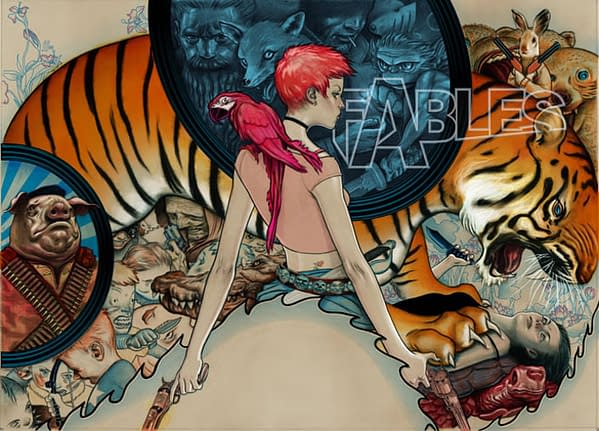
CG: The best way to keep up with us is to sign up for our newsletter and follow us on Facebook. We post updates on Facebook several times a week, and we send out newsletters two or three times each month which detail all of the art that has been added since the previous newsletter, and any special announcements regarding new sales, commission opportunities, convention appearances, etc. We are also active on Twitter, Instagram, etc. A lot of the new art updates are also prominently featured in the slide-show at the top of the comiconart.com home page.
PMcC: So Comiconart is still growing. Are there any other facets of the industry you fancy taking on?
CG: Actually – yes! We are very close to launching a new business venture – Blindbox Comics. Awhile ago I realized that, despite my love of comics and the amount of time I spend working in the industry, I was not as 'informed' on new titles as I would like, and my own comics reading was often months behind.
We're currently set up in Nashville and part of the problem is that the only good local comic store is about 30 minutes away – so it's an hour plus commitment just to walk in the door and browse the shelves.
Similarly, I also don't have enough time to pore over PREVIEWS to decide which new titles I might like to read three months in advance! Working on the assumption that I am not alone in this, I thought it might be a good idea to offer a service that would eliminate all of the time and work involved in finding great new titles worth reading.
At the same time, I also wanted to explore the possibility of adding more excitement for collectors, so we are looking at ways to expand upon and redefine the market for variant cover collectors.
PMcC: So it's a new subscription box service for comics that caters to both collectors and casual readers?
CG: Yes, exactly! And…this venture could also lead to new opportunities for the artists that we currently work with – either by creating more work on the publishing side, or offering another avenue of promotion for books they are working on that are deserving of more attention and exposure. I am very excited about the possibilities presented by Blindbox Comics, and cannot wait for the program to go live.
PMcC: And this is already in the works and on it's way?
CG: Yeah, we will be launching first with a Kickstarter-exclusive 'Beta Box' (our Kickstarter campaign is live right now), with fulfillment by the end of October, and then the first monthly box release will ship in November! There's some great rewards still available.
PMcC: This is what I like to see, people grabbing this industry by the scruff and raising the game. Kudos to you and thank-you for letting us have a glimpse into the world of being a comic book agent and rep. Let's get to those beers we were discussing. Just one last question, I'd pretty much walk the cursed earth for the cover on Prog 727 of 2000AD or sneak into a Cobra stronghold for just one page of Silent Interlude, is there any pages you would love to have in your collection?
CG: I think it would have to be the Fables: Animal Farm cover art by James Jean. I owned this piece several years ago, but ultimately sold it to help fund the purchase of my first house, and have regretted it ever since. That is unquestionably 'the one that got away', and I'd love to get it back one day.

PMcC: Well, I hope you manage it, it's well deserved. In the meantime let's discuss commissioning artwork of me on a throne, dressed as Deadpool, with those losers Scott Summers, Archie Andrews and Jason Todd all kneeling before me in defeat…
CG: Ha – sounds like a plan!
Court Gebeau is the man behind comiconart.com and Blindbox Comics. You can jump on board the Blindbox Kickstarter Campaign Here.
Parker McCombe co-created and writes Samurai City.










